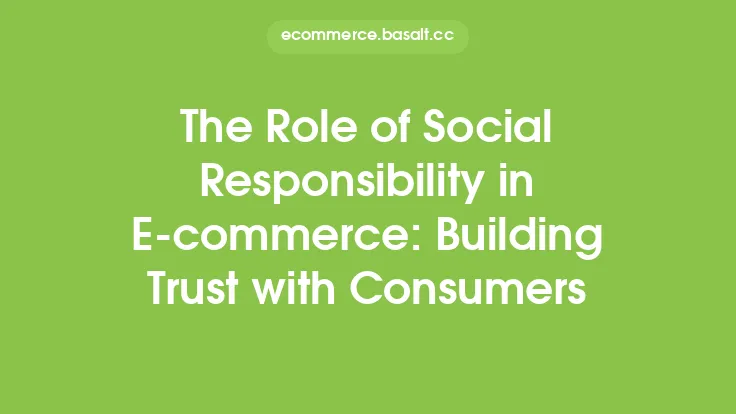In the world of e-commerce, building consumer trust is a crucial aspect of achieving success. With the rise of online shopping, consumers are becoming increasingly cautious about sharing their personal and financial information with online retailers. As a result, e-commerce businesses must prioritize building trust with their customers to establish a loyal customer base and drive long-term growth. In this article, we will explore the importance of consumer trust in e-commerce and provide strategies for building and maintaining trust with online customers.
Introduction to Consumer Trust
Consumer trust refers to the confidence that customers have in an e-commerce business, its products, and its services. It is the foundation upon which all successful e-commerce businesses are built. When customers trust an online retailer, they are more likely to make a purchase, return to the site, and recommend it to others. On the other hand, a lack of trust can lead to abandoned shopping carts, negative reviews, and a loss of business. Building consumer trust requires a combination of transparency, security, and excellent customer service.
Strategies for Building Consumer Trust
There are several strategies that e-commerce businesses can use to build consumer trust. One of the most effective ways is to provide clear and concise product information, including high-quality product images, detailed product descriptions, and customer reviews. This helps to establish transparency and gives customers a clear understanding of what they are buying. Another strategy is to implement robust security measures, such as SSL encryption and secure payment processing, to protect customer data and prevent fraud.
The Role of Customer Service in Building Trust
Customer service plays a critical role in building consumer trust. E-commerce businesses should prioritize providing excellent customer service, including responsive customer support, easy returns and refunds, and personalized communication. This helps to establish a positive relationship with customers and demonstrates a commitment to their satisfaction. Additionally, e-commerce businesses can use customer service to gather feedback and improve their products and services, which further helps to build trust with customers.
The Importance of Transparency and Accountability
Transparency and accountability are essential for building consumer trust. E-commerce businesses should be transparent about their business practices, including their return and refund policies, shipping procedures, and product sourcing. They should also be accountable for any mistakes or issues that may arise, and take steps to rectify them promptly. This helps to establish trust and demonstrates a commitment to fairness and honesty.
Building Trust through Social Proof
Social proof is a powerful tool for building consumer trust. E-commerce businesses can use customer reviews, ratings, and testimonials to demonstrate social proof and establish credibility. They can also use trust badges, such as SSL certificates and security seals, to provide visual cues that indicate a secure and trustworthy website. Additionally, e-commerce businesses can partner with influencers and industry experts to promote their products and services, which can help to build trust and credibility.
Maintaining Consumer Trust over Time
Building consumer trust is not a one-time event, but rather an ongoing process. E-commerce businesses must continually work to maintain trust with their customers by providing excellent customer service, being transparent and accountable, and demonstrating a commitment to their satisfaction. They should also stay up-to-date with the latest security measures and best practices to protect customer data and prevent fraud. By prioritizing consumer trust and taking steps to build and maintain it, e-commerce businesses can establish a loyal customer base and drive long-term growth.
Best Practices for E-commerce Businesses
To build and maintain consumer trust, e-commerce businesses should follow best practices, such as providing clear and concise product information, implementing robust security measures, and prioritizing excellent customer service. They should also be transparent and accountable, and demonstrate a commitment to fairness and honesty. Additionally, e-commerce businesses should stay up-to-date with the latest trends and best practices in e-commerce, and continually work to improve their products and services. By following these best practices, e-commerce businesses can establish trust with their customers and drive long-term success.
Conclusion
Building consumer trust is a critical aspect of achieving success in e-commerce. By providing clear and concise product information, implementing robust security measures, and prioritizing excellent customer service, e-commerce businesses can establish trust with their customers. Additionally, transparency, accountability, and social proof are essential for building and maintaining trust. By following best practices and continually working to improve their products and services, e-commerce businesses can establish a loyal customer base and drive long-term growth. Ultimately, building consumer trust is an ongoing process that requires a commitment to fairness, honesty, and customer satisfaction.




